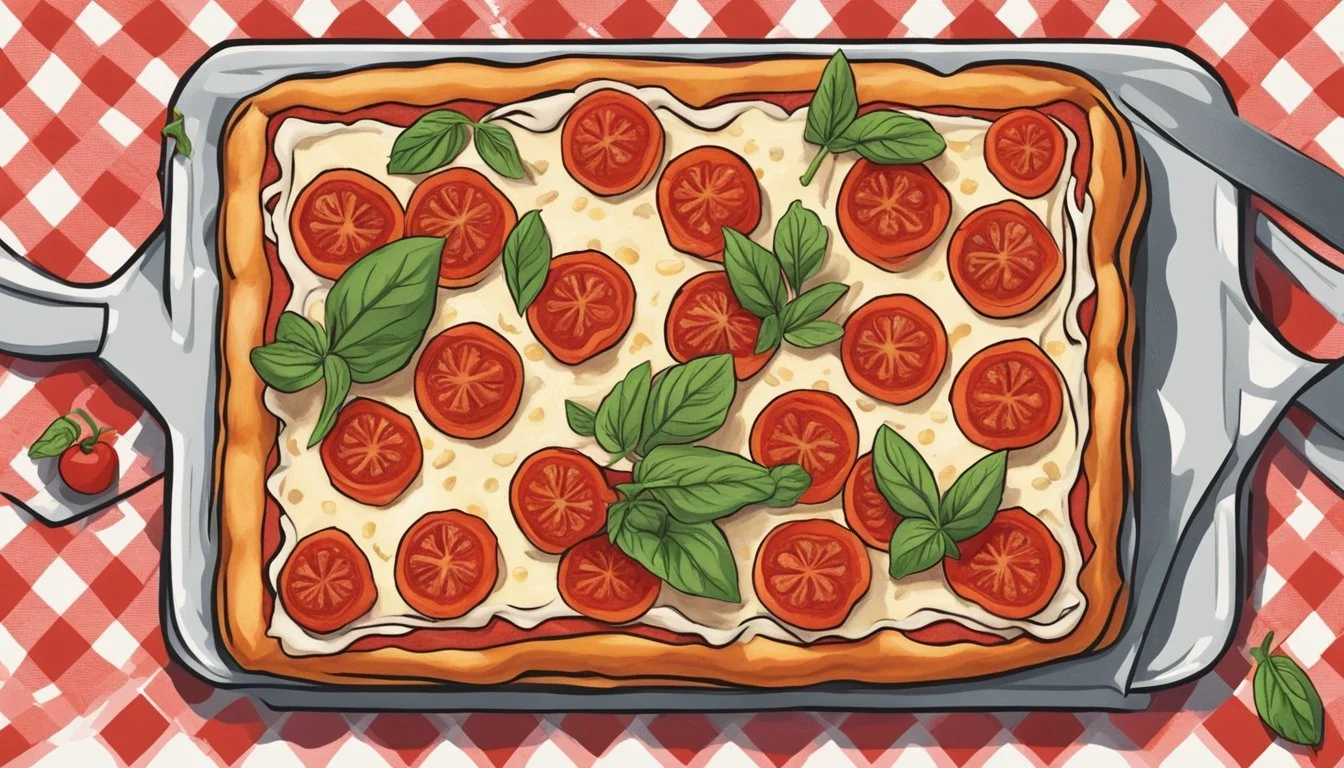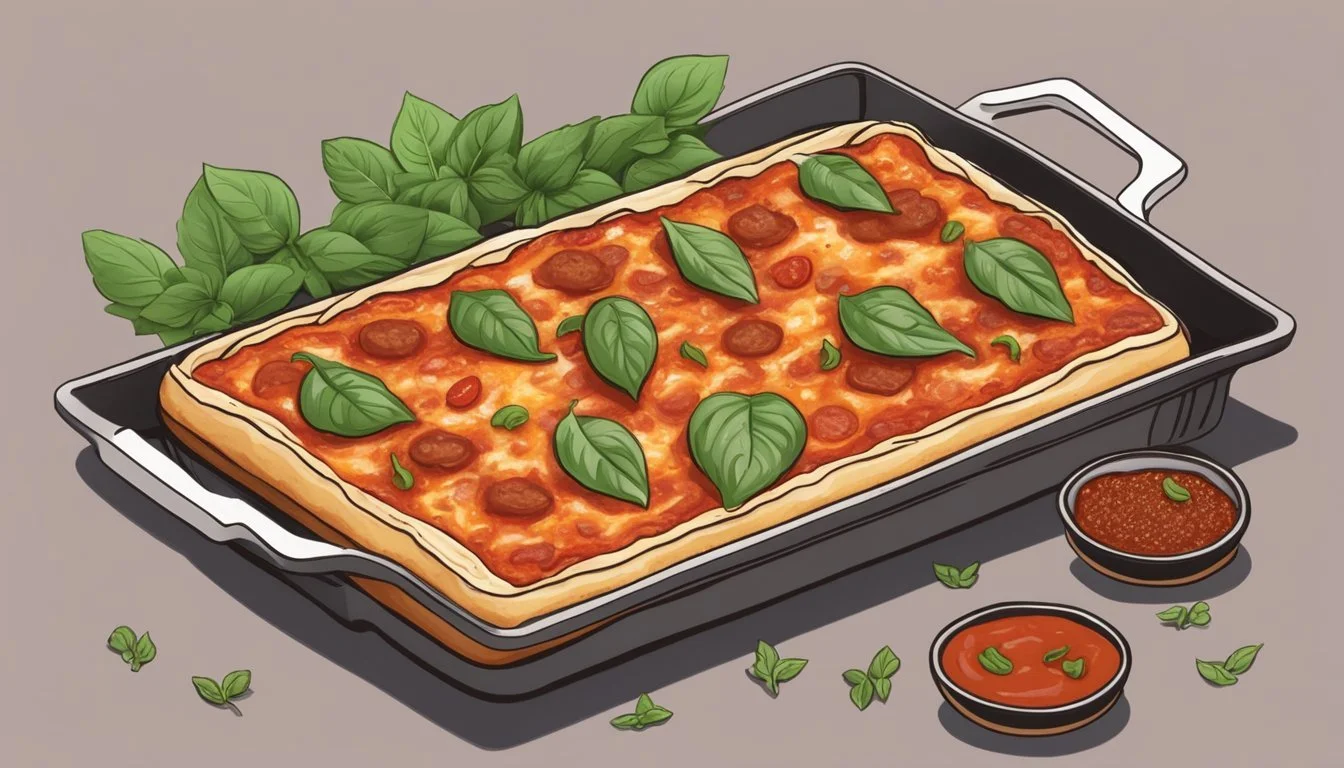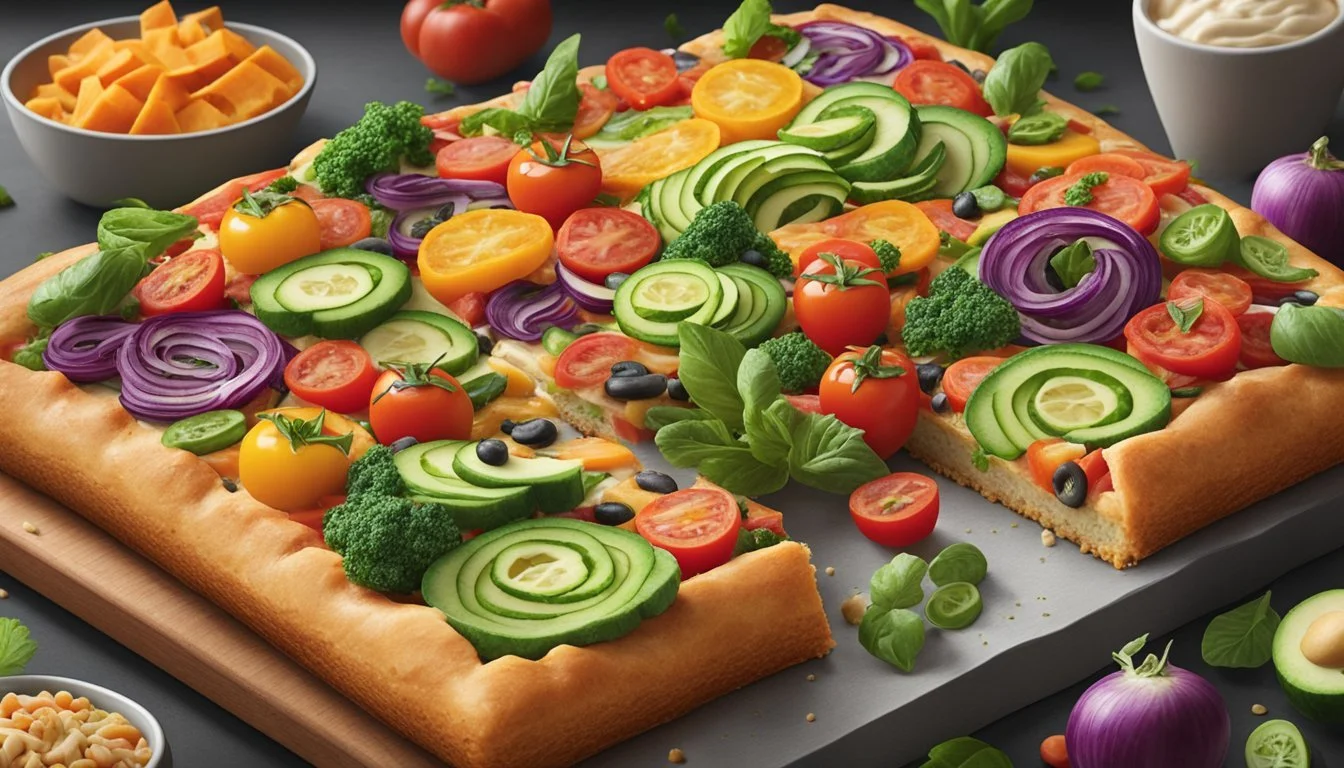Is Detroit-Style Pizza Vegan?
Exploring Plant-Based Options
Detroit-style pizza, (What wine goes well with pizza?) known for its thick, square-cut slices with a crispy, cheese-laden crust, is a culinary staple from the Motor City. This distinctive pizza is traditionally made with a generous amount of dairy-based cheese and a rich, meaty tomato sauce, features that are not vegan-friendly. However, the growing demand for plant-based options has led to the creation of vegan versions of Detroit-style pizza that maintain the characteristic texture and taste without using animal products.
Vegan Detroit-style pizza substitutes dairy cheese with plant-based cheeses made from ingredients like nuts, soy, or root vegetables. These vegan cheeses are designed to melt and stretch similarly to traditional cheese, ensuring the classic experience is preserved. Additionally, the sauce and toppings for a vegan Detroit-style pizza are selected with care, incorporating a mix of fresh vegetables, vegan meats, and herbs to complement the robust flavors of the crust and cheese alternative. Some chefs also offer gluten-free crust options, catering to a broader range of dietary requirements.
As a result, vegan Detroit-style pizza provides an alternative for those following a plant-based diet or with dairy restrictions, while also attracting those simply looking to reduce their meat and dairy intake. With a focus on creativity and inclusivity, pizza makers are reimagining this regional dish to be enjoyed by a diverse array of diners.
What Is Detroit-Style Pizza?
Detroit-style pizza is a distinct type of pie, known for its thick crust, rectangular shape, and a reverse layering of ingredients compared to traditional pizzas.
Historical Origins
Detroit-style pizza dates back to 1946 when it emerged at Buddy's Pizza, a restaurant in Detroit, Michigan. Inspired by Sicilian pizza and adapted for the blue steel pans originally used in automotive factories, this style of pizza has become an iconic dish of the city.
Characteristics of Detroit-Style Pizza
The pizza is recognized for its thick crust that is at once airy and crispy, resembling focaccia. The crust achieves a unique texture partially due to the square pizza pans in which it's baked, which were originally used as trays in the automotive industry. Traditional toppings include pepperoni or sausage, and instead of mozzarella, Wisconsin Brick cheese is used, covering the dough all the way to the edges. This creates a caramelized cheese perimeter. Toppings are placed under the cheese, and finishing stripes of tomato sauce are applied over the top, creating a distinct visual and flavor profile.
Key Characteristics:
Shape: Square or rectangular (squares)
Crust: Thick and similar to Sicilian style, crispy edges
Cheese: Wisconsin Brick, to the edges
Sauce: Stripes applied on top
Comparison to Other Pizza Styles
Detroit-style pizza is often compared to Chicago-style deep-dish and Sicilian-style pizzas. All three styles boast a thicker crust than that of a thin-crust Neapolitan pizza. However, Detroit-style is baked in a rectangular pan, has a light and airy crust rather than the denser crust of a Chicago-style pizza, and typically uses Brick cheese versus the mozzarella found in Sicilian and Chicago-style pizzas. Unlike the wedge-shaped slices of a Chicago-style or Neapolitan pizza, Detroit-style is cut into squares or rectangles.
Essential Ingredients
The ingredients used in making a Detroit-style pizza define its authenticity and flavors. Traditional toppings and cheese, the crust, and the sauce varieties play a pivotal role in rendering this pizza its characteristic taste.
Traditional Toppings and Cheese
In a true Detroit-style pizza, cheese is not just an addition; it is a feature. Brick cheese, which melts beautifully and provides a buttery taste, is traditionally used and goes directly on the dough, with edges reaching the pan to create a caramelized crust upon baking. Toppings like pepperoni are layered under the cheese to infuse the pizza with its flavors during the cooking process.
The Importance of the Crust
A Detroit-style pizza boasts a thick crust that is airy and chewy inside with a crunchy exterior. The crust is made from high-protein bread flour to achieve the desired texture. The unique hydration of the dough and the use of a rectangular steel pan contribute to the crust's signature crisp edges.
Sauce Varieties and Flavors
While tomato sauce is a staple, variations can include seasoning with basil, garlic, oregano, and a touch of sugar to enhance the natural sweetness of the tomatoes. The sauce is typically applied on top of the cheese in dollops. This not only prevents the crust from getting soggy but also creates distinct pockets of flavor with each bite.
Veganizing Detroit-Style Pizza
Detroit-style pizza can be easily adapted to a vegan diet without compromising on the thick, crispy crust and the generous toppings that characterize it. This transformation involves using plant-based cheese, meat-free toppings, and ensuring that the dough and crust are vegan-friendly.
Vegan Cheese Alternates
To mimic the creamy, melted texture of cheese, one can use various vegan cheese alternatives. These include:
Store-bought vegan cheese: There are many brands offering vegan cheese shreds suitable for melting on pizza.
Homemade cheese sauces: A blend of cashews, nutritional yeast, and spices can create a rich, cheese-like sauce.
One should spread the vegan cheese generously across the dough to achieve the characteristic crispy cheese-laden edges of Detroit-style pizza.
Meat-Free Toppings
Traditional Detroit-style pizza is known for its meaty toppings, but numerous plant-based alternatives provide similar flavors and textures, such as:
Vegan pepperoni: Usually made from a combination of vital wheat gluten and spices, it delivers the spicy kick of traditional pepperoni.
Vegan sausage: Plant-based sausages, crumbled and seasoned, offer a savory depth to the pizza topping array.
Besides these, one can also top their pizza with a variety of vegetables to enhance flavor and nutrition.
Vegan Dough and Crust
The foundation of Detroit-style pizza is its thick, chewy crust, which can be made vegan by:
Yeast and warm water: Activating yeast in warm water, as a first step to ensure a well-risen dough.
Vegan dough ingredients: A typical vegan dough recipe includes bread flour, olive oil, salt, and sometimes a touch of sugar to aid the yeast activation process.
The dough should be prepared with care, pressed into an oiled pan to create the thick layers, and baked in a hot oven until the crust becomes golden and crispy.
Creating the Perfect Vegan Dough
Crafting an ideal vegan pizza dough is rooted in understanding the fermentation process, choosing quality flour, and employing precise dough preparation techniques. Each element is pivotal to creating a dough that's flavorful and possesses the right texture for a classic Detroit-style pizza.
The Role of Yeast and Fermentation
Yeast is the driving force behind fermentation, the process that makes pizza dough rise. Instant yeast and active dry yeast are both suitable for vegan doughs, but they are activated differently. Instant yeast blends directly with flour, while active dry yeast is first dissolved in warm water—usually around 95-100°F—to awaken it. The presence of sugar can aid yeast activation, creating the necessary gases to help dough expand during proofing. Extended cold fermentation in a refrigerator can further develop complex flavors in the dough, enhancing the final product significantly.
Selecting the Right Flour
Bread flour is ideal for Detroit-style pizza due to its high protein content, which lends a chewy texture to the crust. It contrasts with all-purpose flour, which can be used but may result in a less crisp exterior. For a distinctly vegan choice, ensure the flour does not contain any additives derived from animal products. Measuring flour by weight ensures accuracy and consistency in dough formation.
Dough Preparation Techniques
The tools and techniques in preparing vegan pizza dough are critical. Start by mixing the dry and wet ingredients in a large bowl until just combined. Use a dough hook on a stand mixer for uniform mixing, or opt for a no-knead pizza dough method, which relies on time to develop gluten, rather than physical kneading. Consistency is key, so the dough should be tacky but not overly sticky. Extra virgin olive oil can be incorporated for a supple texture and to prevent sticking in the sheet pan. A properly pre-heated oven ensures the dough cooks evenly and achieves the characteristic crispy edges that Detroit-style pizza is known for.
Assembling the Pizza
The assembly of a vegan Detroit-style pizza is a deliberate process that ensures each ingredient complements the others, resulting in a crispy crust with bold flavors. Proper layering and baking techniques are crucial for achieving the iconic square pizza's characteristics.
Layering Ingredients
A Detroit-style pizza distinguishes itself with its unique layering sequence:
The Dough: It starts with the dough, stretched to the edges of a well-oiled rectangular pan, allowing for the signature thick and airy crust.
Cheese: Vegan cheese is spread to the very edges, creating a caramelized cheese crust once baked.
Pizza Toppings: (What wine goes well with pizza toppings?) The toppings, which may vary according to preference, are then added. Traditional topping choices for a Detroit-style pizza include pepperoni or sausage, but plant-based alternatives should be used for a vegan variant.
Pizza Sauce: The pizza sauce, thick and herbed, is dolloped onto the pizza in a few stripes after the cheese and toppings, a technique known as "racing stripes."
The layers are strategically placed so that the cheese protects the dough from getting soggy from the sauce, and the crust becomes crispy as the cheese edges fry in the oven.
Baking Techniques
Proper baking technique is vital to ensure the full Detroit experience:
Oven racks: Position the oven rack in the lower third of the oven to help in cooking the thick crust evenly.
Prep Time: Allow the dough to rise according to the recipe's time, which is usually until it doubles in size. Typically, this can take about 1-2 hours.
Cook Time: Preheat the oven to a high temperature, usually around 450-475°F (230-245°C), and bake the pizza for approximately 15-20 minutes or until the edges are dark golden brown and the cheese is bubbly.
Monitoring the pizza during the baking process is crucial to achieving the perfect balance of a crispy crust without burning the topping ingredients.
Topping Variations for Vegan Detroit-Style Pizza
Vegan Detroit-style pizza proves its versatility with an abundance of topping options, from plant-based meats to a variety of vegan cheeses and creative vegetable arrangements. Each chosen ingredient complements the signature thick crust and crispy edges that this pizza style is renowned for.
Plant-Based Meats
For those seeking the savory taste of meat without animal products, plant-based meats are a perfect fit. Vegan pepperoni and Beyond Sausage slices add a spicy and hearty dimension. They can be distributed over the pizza before baking, ensuring that they become slightly crisp, enhancing the texture.
Vegan Cheese Options
Vegan cheese is essential in achieving the gooey, melted quality expected of a pizza. Violife and other vegan cheese brands offer a variety of flavors, including mozzarella and cheddar styles that melt well. Sprinkle a bit of vegan parmesan over the top for an extra punch of flavor.
Mozzarella-style: Ideal for creating a melty base.
Cheddar-style: Adds a sharp, tangy flavor note.
Vegan parmesan: Enhances the overall taste profile when lightly dusted on top.
Innovative Vegetable Toppings
Vegetable toppings offer not only a diverse range of flavors and textures but also bright, appealing colors. Consider layering thinly sliced red onion, mushrooms, and spinach for a hearty bite. A mixture of black olives, garlic, and leafy green toppings like arugula or fresh basil can infuse the pizza with an aromatic and fresh taste.
Mushrooms: Provide a meaty texture.
Spinach and Arugula: Add a mild or peppery green touch.
Olives and Red Onion: Contribute a briny and sharp flavor contrast.
Pineapple and Pickled Jalapeno: Offer a sweet and spicy kick.
By selecting from these toppings, one can customize their Vegan Detroit-style pizza to suit any palate while maintaining the integrity of classic comfort food with a plant-based twist.
Serving and Enjoyment
Detroit-style pizza offers a unique take on the traditional Italian staple, with its square shape and thick, chewy crust. Due to its heftier size, presentation and serving become a crucial part of the dining experience to ensure each slice maintains its distinct edges and cheese-caramelized corners.
Cutting and Presentation
When presenting Detroit-style pizza, one should transfer the pizza onto a cutting board after baking. Given the pizza’s size and structure, it is typically cut into 12 squares, ensuring each piece is sizable and features both the crispy edge and soft interior that this style is known for. A clean, even cut is achieved through the use of a sharp pizza cutter or a large chef's knife. The pizza's edges are one of its highlights; proper cutting accentuates this attribute, serving to enhance the visual appeal and ensure consistent serving sizes.
Pairing with Sides and Drinks
Detroit-style pizza, with its substantial pizza dough base and rich toppings, pairs well with a variety of sides and drinks. Here are some optimal pairings:
Sides:
A simple arugula salad with a lemon vinaigrette pairs well, offering a peppery and citrusy counterbalance to the pizza’s richness.
Garlic breadsticks can be an indulgent companion, complementing the pizza's hearty flavors.
Drinks:
For non-alcoholic options, a sparkling water with lemon provides a refreshing contrast.
In terms of alcoholic beverages, a light-bodied beer or a dry red wine, such as a Chianti, complements the tomato and cheese without overwhelming the palate.








